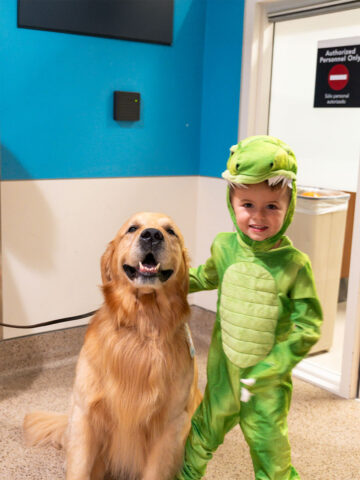Most young children, aged 2 to 4 years, may be prone to having “spirited” behaviors at times. They may whine, yell and throw toys in order to feel seen and heard. Although occasional bad behaviors in young kids may be impossible to prevent entirely, there are ways that parents can promote positive behaviors in their kids.
Here, Dr. Amy Morse, a pediatric psychologist at CHOC, explains how parents can relate to their kids positively and teach them how to manage their emotions.
Developing autonomy in young children
Having a strong parent-child relationship, positive interactions and effective discipline can all help a child develop their sense of autonomy.
Autonomy in childhood is a child’s interest in individuating and exploring their world. To do so, children often observe and start to understand how the adults around them are interacting with others and how others are interacting with them.
It’s so important to help a child develop a sense of autonomy at an early age — it will help them connect with others, understand emotions and demonstrate positive behaviors.
It’s essential, though, to remember that a young child’s demonstration of autonomy may look very different than that of a four- or five-year-old. When children go off to preschool or kindergarten, they start to develop autonomy because of their social relationships. Parents will start to see how they watch others and play; how they look to engage with others and play; how they invite others to play; and how they learn how to receive feedback from peers that may be new.
For younger children though, adults have the greatest impact on their autonomy. This includes parents, adult family members, adult siblings, teachers and others. That’s why it’s so important to develop strong parent-child relationships.
Although it’s important to make sure that children are exploring their world, adults can model behaviors for kids while taking a step back. For example, this is where parents, teachers and others might try to settle their hands or hold their breath as a child takes their first steps, walks down the stairs or pours a glass of milk, thinking, please don’t let them fall or spill milk all over the kitchen table.
By giving children the space to develop autonomy, they are being supported. Parents are silently saying “You can do it.”
The four types of parenting styles
Diana Baumrind, a renowned clinical and developmental psychologist, determined that there are four main parenting styles that can have an immense impact on a child’s development of autonomy. These styles are:
Authoritative
There is a shared agreement that the authoritative parenting style carries the most research across cultures as being positive and supportive, says Dr. Morse. It gives kids space while providing limits.
Permissive
On the other hand, permissive parenting allows children to have maximum control. In this style, parents are warm and accepting, but set few limits and tend to defer to the child for their needs.
Neglectful
As the name suggests, neglectful parenting is when parents are not engaged with children and are not providing limits. They are also not modeling appropriate behavior or providing limits themselves.
Authoritarian
Different from authoritative parenting, authoritarian parenting is high structure but has little consideration of the child’s emotional and behavioral needs.
Task assignments for developing autonomy
Authoritative parenting is the parenting style I recommend, says Dr. Morse.
One way to express authoritative parenting is to help your child develop autonomy by giving them small task assignments. The timing of task assignments often varies by culture, allowing children to begin to develop their individual identities as they start to do things on their own at an early age.
In East Asian cultures, children as young as age 3 or 4 years may be asked to do small errands on their own like walking to the market nearby to pick up a grocery item.
In other cultures, like Euro-American families, task assignments are typically assigned to older children. Euro-Americans might take a different approach to task assignment; they might choose to wait and allow a child to be able to demonstrate autonomy around the home before doing tasks that take place outside the home.
Cooperation vs. coercion
Task assignments can be a wonderful way to model cooperation to children, just like the strategies for discipline mentioned above. When their family, community and culture is promoting a sense of autonomy, children may be able to better comply with requests, tasks or chores from their parents. On the other hand, without a sense of autonomy, children may have to be coerced to complete necessary tasks through rewards.
To increase that cooperation from your children, consider your culture, your family values and what you see in the children of your family. By promoting autonomy and by giving your children the support they need to be independent, you can help bolster their cooperation.
Development of a child’s emotional regulation through co-regulation and self-regulation
As part of developing autonomy, children may start to learn how to regulate their emotions. At an early age, children may start to have emotions for the first time and learn how it feels when that experience occurs in their bodies.
Emotions for young children may be simple at first. They may be happy, sad or mad. But as they age, they may begin to develop an awareness of more complex emotions like frustration, elation and excitement.
For parents and caregivers, this can be an opportunity to help to strengthen children’s emotional vocabulary so they can better understand the connection between experience, how their body reacts and what they can do in response to that emotion. Parents can help their kids understand emotions by promoting co-regulation and self-regulation.
Co-regulation
Co-regulation is the partnership between an adult and child during their developmental trajectory. Parents can help their children learn how to develop coping skills and decompress from having intense emotions. With co-regulation, kids may develop an age-appropriate sense of emotional awareness and know who they can go to when they are feeling upset. Together, parents and children can identify an adult in a home setting and in a school or a community setting that they would go to if they were feeling upset.
Self-regulation
Then, through co-regulation, children may develop self-regulation. Self-regulation is the sense of independence that a child receives when they can understand what it feels like in their body to be mad, for example. They may realize that they get hot, and their muscles get tense. Then, they know what they need to do to relieve that emotion — they might need to step away, squeeze a pillow or take three deep breaths.
That sense of self-regulation is a freeing thing for a child because they can begin to develop a sense of agency that they can manage difficult situations and emotions.
With parents’ help, children can begin to navigate their way from challenging behaviors to autonomy to emotional regulation — preparing them to grow into emotionally healthy kids, teens and adults.
P.R.I.D.E skills for positive interactions with kids
Parents can help young children develop a healthy sense of autonomy, co-regulation and self-regulation by using strategies that are part of parent-child interaction therapy. Parent-child interaction therapy is an evidence-based behavioral treatment that places emphasis on improving the quality of the parent-child relationship and changing parent-child interaction patterns.
In order to create positive experiences and promote positive behavior in young children, parents should focus on the language that they use when spending time with their child. They are called the P.R.I.D.E Skills, which is an acronym for praise, reflect, imitate, describe and enjoy. These skills can be used during that special one-on-one time to help to promote that sense of attachment between an adult and a child.
Here’s how you can practice P.R.I.D.E skills with your family:
Praise
Praise is used when complimenting children’s positive behavior. It lets the child know that their parent is paying attention to them and expressing how much they like compliant behavior. Praise can make both you and your child feel good!
When offering your child praise, it’s better to label your compliment to them versus not labeling it. The following are examples of unlabeled and labeled praises:
- Unlabeled: “Nice job, buddy! Thank you!”
- Labeled: “Nice job putting those toys away!”
Labeled praises are preferred because they are more effective — they let your child know exactly what you like. In addition, behavior that it praised is more likely to be repeated. It also helps to promote attachment and self-esteem.
Reflect
Reflect is when parents comment on their child’s appropriate words. To do this, you may feel like you’re a sports commentator. For example, if your child says, “The car is big!” You might go on to say, “Yes, the car is big and orange!”
When reflecting, you are following your child’s lead, which shows them that you are present and listening.
Imitate
By imitating, you will join in and follow your child’s appropriate play. This means that if your child switches to a new activity, you can follow along. Keep the play at your child’s developmental level, and you may even have fun yourself! Imitating shows approval and enjoyment, and helps to boost attachment and self-esteem.
Describe
For describing, you might want to put on your sports commentator hat again. During play, you’ll use a behavior description to describe what your child is doing. For example, you could say, “You’re racing your cars around the track!”
In addition, describing always includes “you” as the reference to the child and the action that the child is engaged in. It is not about what the adult is doing or the toys. The following are additional examples of “you” statements:
- You are building a tall tower.
- You’re stacking the blue block on top of the red one.
Enjoy
Enjoy is the last of the P.R.I.D.E skills, and it’s to have fun. This special, uninterrupted time with your child is a wonderful opportunity to be present and show them that they’re seen and heard. Life is so busy — so this is a chance for you to slow down and promote attachment while having fun with your child.
It’s also important to show that you are happy to play with your child! You can do so in the following ways:
- Use an interested, enthusiastic and playful tone of voice.
- Laugh with your child.
- Show physical affection through hugs and backrubs.
- Talk about your enjoyment.
Watch a webinar on this topic, presented by Dr. Morse, as part of CHOC’s Mental Health Education Program (MHEP). MHEP offers free webinars to parents on a variety of timely topics. To view upcoming webinars, view the MHEP events calendar. You can also watch all recently aired MHEP webinars in the archive here.
Get more expert health advice delivered to your inbox monthly by subscribing to the KidsHealth newsletter here.
Get mental health resources from CHOC pediatric experts
The mental health team at CHOC curated the following resources on mental health topics common to kids and teens, such as depression, anxiety, suicide prevention and more.





